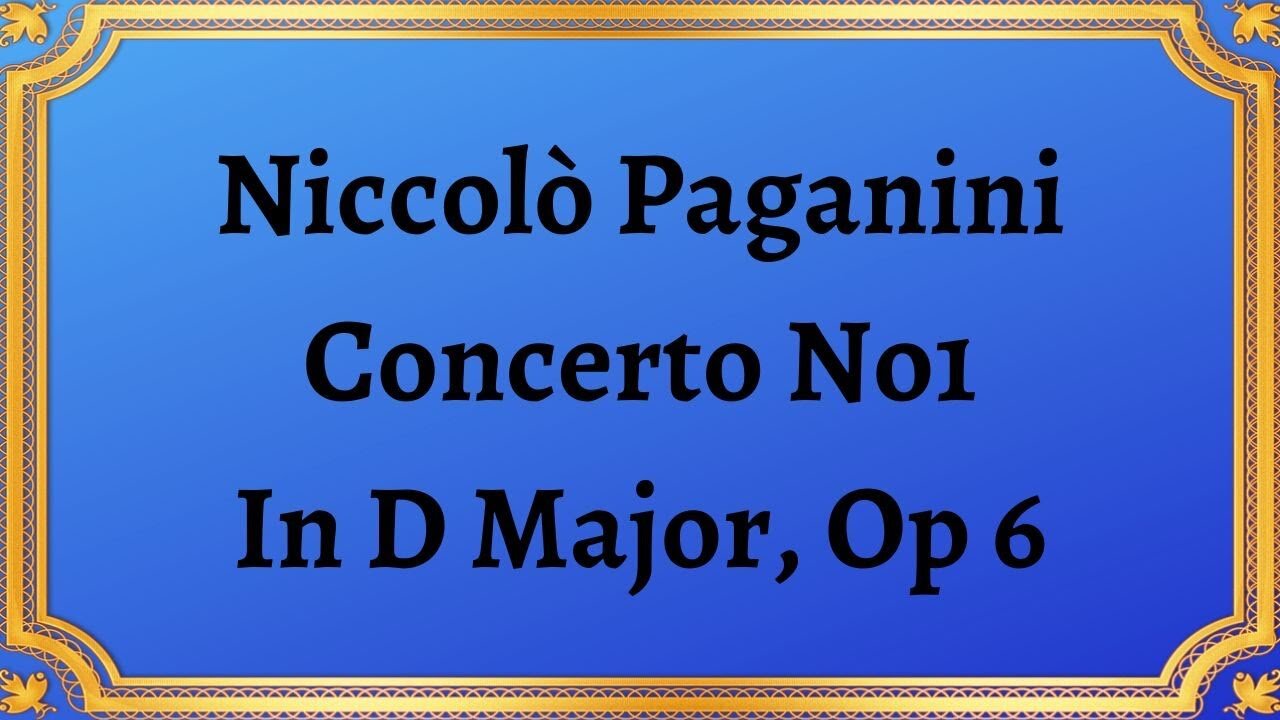Premium Only Content

Niccolò Paganini Concerto No1 In D Major, Op 6
#NiccoloPaganini #ConcertoNo1 #DMajor #Opus6 #ClassicalMusic #Violin #MusicalComposition #ItalianMusic #Virtuosic #MusicHistory #MusicAnalysis #MusicTheory #MusicPerformance #MusicEducation #MusicAppreciation #MusicCriticism #ConcertReview #Musicology
Publication date 1950
ZINO FRANCESCATTI, Violin, with THE PHILA- DELPHIA ORCHESTRA, EUGENE ORMANDY, Conductor
Niccolò Paganini was an Italian composer, violinist, and guitarist who is widely regarded as one of the greatest virtuosos of all time. His music, characterized by its technical complexity and expressiveness, has been influential in classical music to this day. One of his most famous works is Concerto No. 1 in D Major, Op. 6, which showcases Paganini's exceptional skills and mastery of the violin.
Paganini's Concerto No. 1 in D Major, Op. 6, was first performed in 1819, and it is one of his most significant concertos. It features three movements that are each renowned for their technical complexity and emotional depth.
The first movement, Allegro maestoso, is an intense and technically demanding piece that showcases Paganini's incredible control over the instrument. The violinist must navigate the fast-paced arpeggios and trills with precision, making the movement a challenging piece to perform. The violin's virtuosic writing in this movement is matched by the orchestra, which provides a dramatic and thunderous accompaniment.
The second movement, Adagio espressivo, is a lyrical and expressive piece that contrasts the first movement's technical virtuosity. This movement highlights Paganini's skills as a composer, with the violin soaring over a beautiful orchestral accompaniment. The soloist must use slow bowing techniques to create a gentle and emotional sound, drawing the listener's attention to the vibrant melody.
The final movement, Rondo: Allegro spirituoso, is a fast and exciting piece that features numerous technical passages and virtuosic ornamentation. The violinist must play at a breakneck pace to keep up with the intricate melodies and harmonies that characterize this movement. The orchestra's rhythmic accompaniment complements the violin's technical brilliance, providing a satisfying conclusion to the concerto.
Paganini's Concerto No. 1 in D Major, Op. 6, is renowned for its technical demands and emotional depth. The piece highlights Paganini's mastery of the violin and his abilities as both a composer and a performer. The concerto continues to inspire violinists, composers, and music lovers to this day, cementing Paganini's status as one of the most innovative and influential composers in classical music.
You have the opportunity to support the channel https://destream.net/live/RadSiarAl/donate
-
 UPCOMING
UPCOMING
theDaily302
10 hours agoThe Daily 302-Special Border Invasion Shutdown Show
128 -
 4:29:05
4:29:05
Tate Speech by Andrew Tate
11 hours agoEMERGENCY MEETING EPISODE 92 - IN THE TRENCHES
724K1K -
 1:01:23
1:01:23
In The Litter Box w/ Jewels & Catturd
23 hours agoThe Trump Effect | In the Litter Box w/ Jewels & Catturd – Ep. 696 – 11/21/2024
64.6K24 -
 20:53
20:53
SLS - Street League Skateboarding
2 days agoGold Medals, World Class Food, Night life & more - Get Lost: Tokyo
64.7K7 -
 47:13
47:13
PMG
19 hours ago $0.78 earned"Hannah Faulkner and Doug Billings | WHY LIBERALS LOST THE ELECTION"
34K -
 59:01
59:01
The Liberty Lobbyist
5 hours ago"We Only Have NOW To Make a Difference"
34.2K2 -
 4:16:41
4:16:41
CatboyKami
7 hours agoStalker 2 Blind playthrough pt1
33.9K2 -
 1:06:27
1:06:27
Russell Brand
7 hours agoNeil Oliver on the Rise of Independent Media, Cultural Awakening & Fighting Centralized Power –SF498
206K273 -
 1:39:14
1:39:14
vivafrei
7 hours agoSoros Karma in New York! Tammy Duckwarth Spreads LIES About Tulsi Gabbard! Pennsylvania FLIPS & MORE
100K75 -
 1:57:36
1:57:36
The Charlie Kirk Show
7 hours agoInside the Transition + The Bathroom Battle + Ban Pharma Ads? | Rep. Mace, Tucker, Carr | 11.21.24
150K66